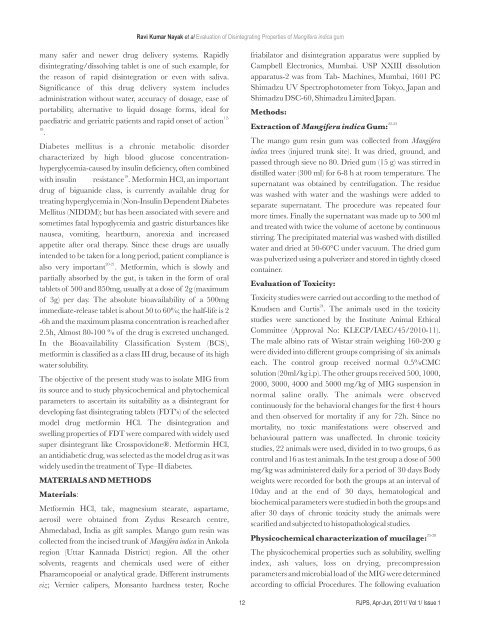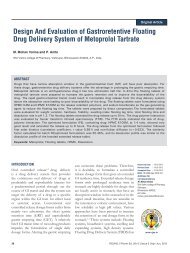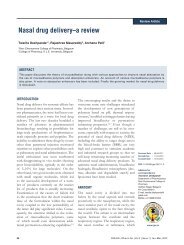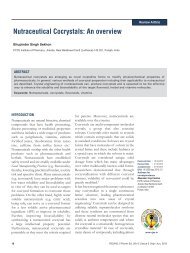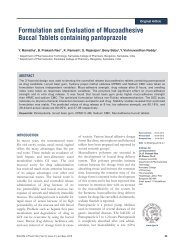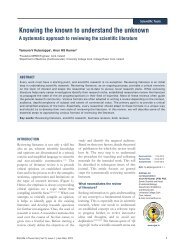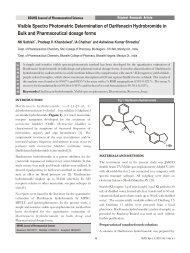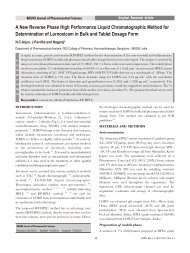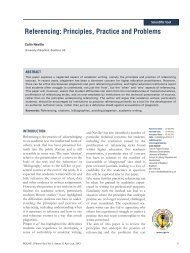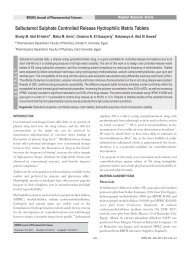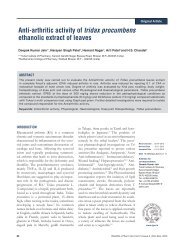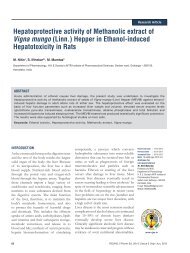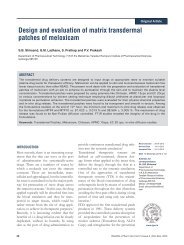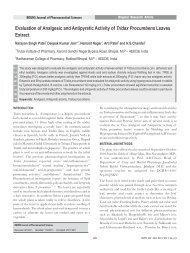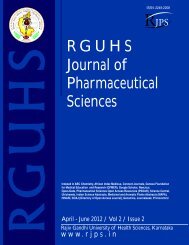final .cdr
final .cdr
final .cdr
Create successful ePaper yourself
Turn your PDF publications into a flip-book with our unique Google optimized e-Paper software.
many safer and newer drug delivery systems. Rapidly<br />
disintegrating/dissolving tablet is one of such example, for<br />
the reason of rapid disintegration or even with saliva.<br />
Significance of this drug delivery system includes<br />
administration without water, accuracy of dosage, ease of<br />
portability, alternative to liquid dosage forms, ideal for<br />
12paediatric<br />
and geriatric patients and rapid onset of action<br />
18<br />
.<br />
Diabetes mellitus is a chronic metabolic disorder<br />
characterized by high blood glucose concentrationhyperglycemia-caused<br />
by insulin deficiency, often combined<br />
19<br />
with insulin resistance . Metformin HCl, an important<br />
drug of biguanide class, is currently available drug for<br />
treating hyperglycemia in (Non-Insulin Dependent Diabetes<br />
Mellitus (NIDDM); but has been associated with severe and<br />
sometimes fatal hypoglycemia and gastric disturbances like<br />
nausea, vomiting, heartburn, anorexia and increased<br />
appetite after oral therapy. Since these drugs are usually<br />
intended to be taken for a long period, patient compliance is<br />
20-21<br />
also very important . Metformin, which is slowly and<br />
partially absorbed by the gut, is taken in the form of oral<br />
tablets of 500 and 850mg, usually at a dose of 2g (maximum<br />
of 3g) per day. The absolute bioavailability of a 500mg<br />
immediate-release tablet is about 50 to 60%; the half-life is 2<br />
-6h and the maximum plasma concentration is reached after<br />
2.5h, Almost 80-100 % of the drug is excreted unchanged.<br />
In the Bioavailability Classification System (BCS),<br />
metformin is classified as a class III drug, because of its high<br />
water solubility.<br />
The objective of the present study was to isolate MIG from<br />
its source and to study physicochemical and phytochemical<br />
parameters to ascertain its suitability as a disintegrant for<br />
developing fast disintegrating tablets (FDT's) of the selected<br />
model drug metformin HCl. The disintegration and<br />
swelling properties of FDT were compared with widely used<br />
super disintegrant like Crosspovidone®. Metformin HCl,<br />
an antidiabetic drug, was selected as the model drug as it was<br />
widely used in the treatment of Type–II diabetes.<br />
MATERIALS AND METHODS<br />
Materials:<br />
Metformin HCl, talc, magnesium stearate, aspartame,<br />
aerosil were obtained from Zydus Research centre,<br />
Ahmedabad, India as gift samples. Mango gum resin was<br />
collected from the incised trunk of Mangifera indica in Ankola<br />
region (Uttar Kannada District) region. All the other<br />
solvents, reagents and chemicals used were of either<br />
Pharamcopoeial or analytical grade. Different instruments<br />
viz; Vernier calipers, Monsanto hardness tester, Roche<br />
Ravi Kumar Nayak et al Evaluation of Disintegrating Properties of Mangifera indica gum<br />
12<br />
friabilator and disintegration apparatus were supplied by<br />
Campbell Electronics, Mumbai. USP XXIII dissolution<br />
apparatus-2 was from Tab- Machines, Mumbai, 1601 PC<br />
Shimadzu UV Spectrophotometer from Tokyo, Japan and<br />
Shimadzu DSC-60, Shimadzu Limited Japan.<br />
Methods:<br />
22-23<br />
Extraction of Mangifera indica Gum:<br />
The mango gum resin gum was collected from Mangifera<br />
indica trees (injured trunk site). It was dried, ground, and<br />
passed through sieve no 80. Dried gum (15 g) was stirred in<br />
distilled water (300 ml) for 6-8 h at room temperature. The<br />
supernatant was obtained by centrifugation. The residue<br />
was washed with water and the washings were added to<br />
separate supernatant. The procedure was repeated four<br />
more times. Finally the supernatant was made up to 500 ml<br />
and treated with twice the volume of acetone by continuous<br />
stirring. The precipitated material was washed with distilled<br />
water and dried at 50-60°C under vacuum. The dried gum<br />
was pulverized using a pulverizer and stored in tightly closed<br />
container.<br />
Evaluation of Toxicity:<br />
Toxicity studies were carried out according to the method of<br />
24<br />
Knudsen and Curtis . The animals used in the toxicity<br />
studies were sanctioned by the Institute Animal Ethical<br />
Committee (Approval No: KLECP/IAEC/45/2010-11).<br />
The male albino rats of Wistar strain weighing 160-200 g<br />
were divided into different groups comprising of six animals<br />
each. The control group received normal 0.5%CMC<br />
solution (20ml/kg i.p). The other groups received 500, 1000,<br />
2000, 3000, 4000 and 5000 mg/kg of MIG suspension in<br />
normal saline orally. The animals were observed<br />
continuously for the behavioral changes for the first 4 hours<br />
and then observed for mortality if any for 72h. Since no<br />
mortality, no toxic manifestations were observed and<br />
behavioural pattern was unaffected. In chronic toxicity<br />
studies, 22 animals were used, divided in to two groups, 6 as<br />
control and 16 as test animals. In the test group a dose of 500<br />
mg/kg was administered daily for a period of 30 days Body<br />
weights were recorded for both the groups at an interval of<br />
10day and at the end of 30 days, hematological and<br />
biochemical parameters were studied in both the groups and<br />
after 30 days of chronic toxicity study the animals were<br />
scarified and subjected to histopathological studies.<br />
25-28<br />
Physicochemical characterization of mucilage:<br />
The physicochemical properties such as solubility, swelling<br />
index, ash values, loss on drying, precompression<br />
parameters and microbial load of the MIG were determined<br />
according to official Procedures. The following evaluation<br />
RJPS, Apr-Jun, 2011/ Vol 1/ Issue 1


